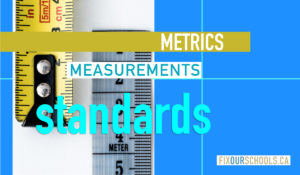Ventilation is a key aspect of keeping people safe during the COVID-pandemic. With schools opening soon for in-person learning for the first time in many months, amidst what has been confirmed to be the fourth wave of the COVID-pandemic in Ontario, ventilation in schools is understandably a hot topic.
The August 13, 2021 Toronto Star article by Sarah Mojtehedzadeh and May Warren entitled, “Many major school ventilation upgrades won’t be ready by September. Here’s what you need to know about the precautions in place” does an outstanding job of providing details on what to expect at schools in various school boards across the province relative to ventilation this September. The Toronto Star team contacted all 72 Ontario school boards to ask for details on ventilation improvements and upgrades in their schools, and heard back from 30 school boards.
We applaud the transparency and candour of these 30 school boards who responded to the Toronto Star. Fix Our Schools has also been so appreciative of school boards such as the Hamilton Wentworth District School Board (HWDSB) and the Toronto District School Board (TDSB), that are being transparent on a school-by-school basis about ventilation, and also endeavouring to educate us about the complexities of ventilation.
If you do not see your local school board’s ventilation details in the Toronto Star report, nor are you able to find ventilation details on your school board’s website, please contact your local Trustee and Chair to let them know you expect transparency on the safety of classrooms, and that you want to know details on ventilation improvements, upgrades, and, ideally, data on indoor air quality in your local classrooms and schools. Students, teachers, and education workers deserve transparency as they head back to classrooms. In elementary classrooms, where most students are too young to get vaccinated, ventilation is even more critically relied upon as a measure to reduce the spread of COVID in classrooms.
The August 13th Toronto Star article also shares that, while some ventilation upgrades will not be ready in time for the first day back at school, Ontario’s 72 school boards will be installing air-purifying HEPA filters in all classrooms without mechanical ventilation, as per this Ministry of Education memo 2021:B14 on school ventilation, dated August 4.
Jeffrey Siegel, a professor of civil engineering at the University of Toronto, calls this an “enormously important” step. Engineer David Elfstrom cautions that careful monitoring and oversight is required to ensure the HEPA filters are used correctly. He notes that if these air-purifying units are, for instance, run on too low a speed, the space “won’t be much better than what they had to start with.” Elfstrom also suggests that many non-mechanically ventilated classrooms may require more than one air purifier to be effective.
Therefore, even though Mr. Elfstrom sees many positive aspects to the provincial government’s back-to-school plan, he suggests that it would be much stronger if the Province also included specific target metrics.
Elfstrom’s main concern is for the schools that do not yet have mechanical ventilation. “I am worried about the classrooms that have either zero mechanical ventilation or only just an exhaust fan type of ventilation. Those are the ones that the ministry is asking to put a HEPA filter in, but not specifying what the target should be,” said Elfstrom. He goes on to say that without clear provincial targets in place for the indoor air quality to be achieved through having these HEPA filters in classrooms, it is highly possible that classrooms without mechanical ventilation and only one HEPA filter may not achieve the same minimum level of ventilation of classrooms with mechanical ventilation, resulting in ventilation inequity across classrooms.
“If you set a target, then you actually have something to work towards. And so far, nothing from even the latest memo from the Ministry of Education has any targets,” Elfstrom notes. Jessica Lyons of the Ontario Parent Action Network is also cited in the August 13 Toronto Star article. Lyons expresses concern about the lack of any transparency on the metrics that are trying to be achieved with ventilation improvements, and wonders who will monitor the outcome of the myriad of ventilation upgrades and improvements.
David Elfstrom suggests that the use of carbon dioxide monitors in classrooms could serve as a proxy for air quality, even though CO2 levels don’t correlate with COVID-19 transmission risks. However, the Ministry of Education is leaving it to school boards to decide whether to use CO2 monitors. Knowing that $600-million is being invested in school ventilation improvements and upgrades, Fix Our Schools cannot fathom why our provincial government is not willing to actually measure indoor air quality and ensure that the money invested has yielded desired outcomes.
The COVID-19 pandemic has certainly brought an urgency to the importance of proper ventilation and good indoor air quality that Fix Our Schools has not seen since we began our advocacy in 2014. Clearly, in the coming months, the obvious and urgent main goal of ventilation improvements is to lower COVID transmission in classrooms. However, going forward, improved ventilation and better indoor air quality in classrooms and schools can lead to better learning environments with better academic results, better attendance, and better health for students, teachers and education workers. With so many reasons to get this right, Fix Our Schools looks to Premier Ford to fund metrics, targets and systems immediately so that good ventilation and indoor air quality are forevermore embedded as key aspects of any public learning environment.
Jeffrey Siegel, a professor of civil engineering at the University of Toronto, sums the situation up nicely, stating that “ultimately, greater focus on ventilation issues is crucial — and should have started earlier”. Katharine Smart, president-elect of the Canadian Medical Association also summed things up nicely, stating in her opinion piece in the Globe & Mail on August 16, 2021, “with the knowledge that the virus is airborne, why are we not addressing school ventilation urgently?”.

